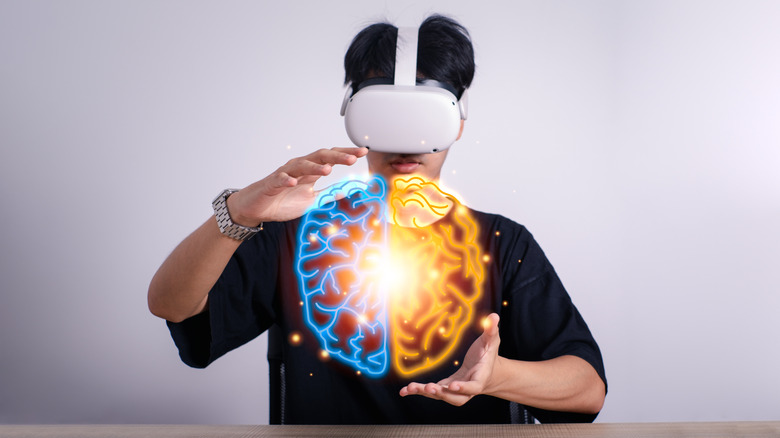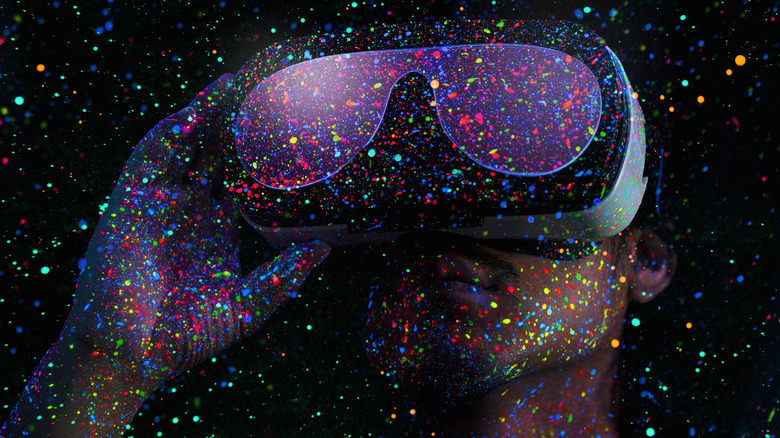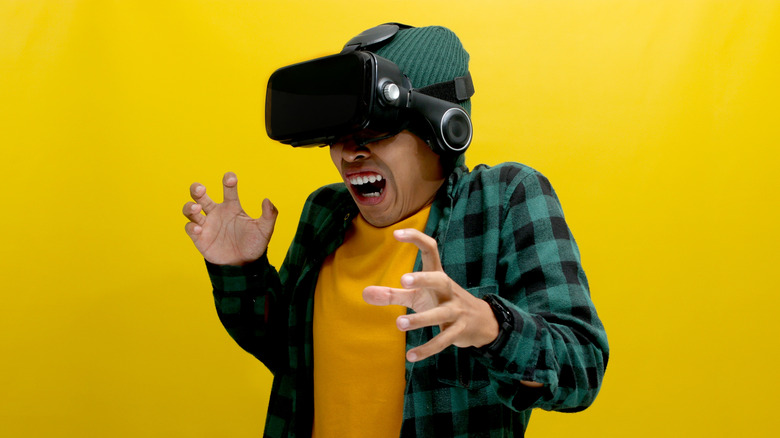
The ultimate goal of VR technology is to transport you to another place without the need to leave your living room. Companies like Meta, Microsoft, and others have invested billions into making virtual reality feel more like, well, reality. This involves not only technology to make screens more vivid or body tracking more accurate, but also psychological experimentation. The human mind is a powerful perceptual machine that can easily adapt to new environments, and by taking advantage of that, VR companies hope to accomplish with your mind what hardware alone cannot. But already, people are finding out just how willing your brain is to play along.
Advertisement
Many VR users are now chasing a particular hallucination known as phantom sense. Imagine you’ve got a Meta Quest 3 strapped to your head, and you’re standing in a virtual meadow. The sun beams overhead, and you feel hot. The breeze rustles a ridge of tall grasses nearby, and you get goosebumps. A mosquito buzzes near your ear, and you instinctively slap the back of your head. All of these are examples of the phantom sense. Neither your VR headset nor its controllers have any technology to make you feel heat, wind, or bugs crawling on you — your brain is filling those blanks in for you to help make sense of what it sees.
So, what exactly is phantom sense, why does it happen, and how can you experience it yourself? To answer that, we’re going to explore some of the most unnerving elements of human perception and psychology. So strap in as we go on a meta-level quest to explore the strange phenomenon of phantom sense.
Advertisement
Phantom sense is a psychological process triggered in VR

Simply put, a phantom sense is any physical sensation you experience while in VR that is not created by the VR headset, software running on it, or accessories but rather by your own mind. Using the above example of being in a VR meadow, if the presence of a VR sun makes you feel its warmth on your skin, or if the sound of wind accompanied by waving grain in the meadow simulation causes you to feel a breeze, those are both phantom senses.
Advertisement
What’s actually occurring is a psychological process similar to phantom limb pain. In one experiment, a rubber hand is placed where a subject would expect their own hand to be. The rubber hand is then stabbed with a needle, causing the subject to experience pain as though it was really their hand. Researchers have performed similar experiments in virtual reality. In a 2023 study published in Scientific Reports, researchers Artur Pilacinski, Marita Metzler, and Christian Klaes immersed subjects in virtual reality scenarios and then asked them to stroke their bodies using a virtual object. Subjects reported a tingling sensation in the same area on their actual bodies, which the researchers referred to as phantom touch illusion or PTI.
Advertisement
The phantom sense phenomenon was theorized in the VR study to be caused by top-down perception. On a simple level, top-down perception is when your brain uses the information it already knows about the world to fill in gaps. We do this all the time in other, more obvious ways. For instance, if you get food poisoning from chicken, you may later feel nauseous when seeing or smelling chicken. Similarly, the image of a sun in the sky when in a VR setting may cause you to perceive a sensation of warmth since your brain associates that sensation with the sun.
Does everyone experience VR phantom sense?

Although the phenomenon of phantom sense is relatively common among VR users, not everyone reports experiencing it. It is not currently known what percentage of users will experience phantom sensations, but some find it desirable. After all, if the goal of VR is to replicate reality as closely as possible, it takes more than a screen in front of your eyes and a pair of headphones to do so. Touch, smell, taste, and other senses cannot be replicated on a hardware level (at least for now), so the ability of your brain to make you hallucinate those senses adds to the immersion of the VR experience.
Advertisement
Some developers of VR games and other programs could try to induce phantom sensations in users by applying research on the subject, which uses techniques that cause the user to feel like they more naturally inhabit a virtual body. On the user side, in forums on Reddit and elsewhere, some VR users have taken to sharing tips that they theorize may help to induce phantom sensations, though we don’t recommend trying any of them. Importantly, there does not seem to be a consensus among users regarding what triggers phantom sense. If you want to experience it yourself, you might need to try a variety of methods, none of which are guaranteed to work and could be unsafe, depending on the scenario.
The negative side of phantom senses in VR

For some users, virtual reality causes motion sickness symptoms including nausea and dizziness that can be reduced, and products like the Neurosync C-Infinity aimed at combatting it. Scientists don’t yet know why this occurs, though there are theories. Some hypothesize that it’s caused by experiencing virtual motion even though your body isn’t moving in real life or different types of VR projection technologies contribute to it. When it comes to phantom sensations, they could be used to induce similarly unpleasant sensations for some users. Just like in the study where a needle was pushed through a rubber arm and the subject felt stabbing pain, there could be a way to induce this in the future intentionally.
Advertisement
Ultimately, if you want to experience a phantom sense in virtual reality, you should do so in a private setting at first, making sure to take breaks if you find yourself overwhelmed. VR can be a wonderful, almost magical experience, and safely experiencing phantom sense can take it to the next level.



